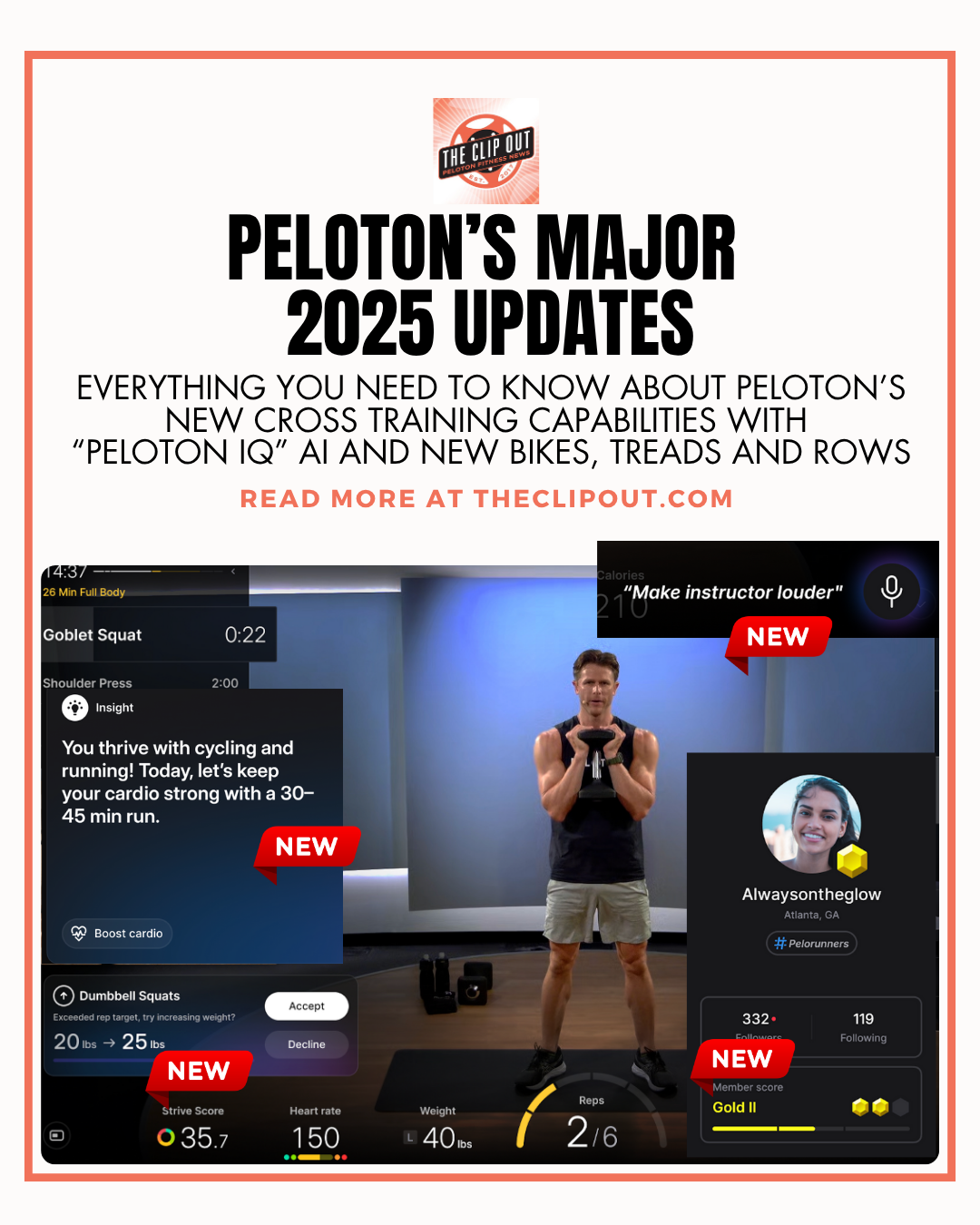Peloton’s FY2025 Q3 Earnings Call: A Holisitic Approach to the Future
Peloton Q3 2025 Earnings Summary: Financial Wins and Member Updates
Peloton has just wrapped up Q3 2025, and there’s plenty to unpack. With new CEO Peter Stern at the helm and leading this call for the first time (proudly noting he’s now a member of the employee Century Club), the company has made strides in balancing financial improvement with an evolving member experience. Listening to the Earnings Call, it is clear that Stern has tremendous respect for the capacities of his employees and wants to empower them to do their very best work. As a longtime Peloton user himself, he does seem to understand what can be exciting for some members.
From financial highlights to exciting feature developments, here’s everything you need to know about Peloton’s recent performance.
Objectives Recap
Peloton outlined four key objectives for FY25, which underpinned their Q3 strategy and operations.
- Improve Member Outcomes
Deliver better equipment, smarter software, and engaging coaching to maximize value for members.
- Meet Members Everywhere
Expand Peloton’s reach by boosting awareness and offering access both online and offline.
- Create Members for Life
Strengthen relationships with members to extend their lifetime commitment to Peloton.
- Operate with Business Excellence
Focus on optimizing pricing, slashing costs, and increasing profitability for sustainable growth.
Financial Highlights
Peloton’s Q3 results show some significant wins despite challenging market conditions.
By the Numbers
- Total Revenue: $624 million, exceeding analyst estimates but reflecting a 13% year-over-year decline.
- Net Cash Provided by Operations: Over $96.7 million, marking five consecutive quarters of positive Free Cash Flow.
- Net Loss: Narrowed to $47.7 million, a significant improvement compared to the $167.3 million loss reported one year ago.
- Gross Margin: Improved to 51.0% from 43.1% year-over-year, driven by a shift toward higher-margin subscription revenues.
- Ending Paid Connected Fitness Subscriptions: 2.88 million, hitting the high end of guidance despite being 6% lower year-over-year.
Peloton also raised its FY25 revenue forecast to $2.455 – $2.470 billion, an increase of $7.5 million from the midpoint of previous estimates.
Operational Efficiency
Cost optimization efforts are paying off. Total operating expenses decreased by 23%, with a 37% cut in sales and marketing spend. This disciplined approach is helping Peloton invest more in its member experience while steadily deleveraging its balance sheet. Net debt dropped by 35% year-over-year, showcasing significant progress in reducing financial risk.
Doing More of What’s Working Well
Peloton is doubling down on areas that continue to resonate with members. As we wait for a more complete strategic plan to emerge later this year, here are the highlights from their member-focused initiatives:
- Pace Targets Expanding
Already a hit with runners, Pace Targets will soon be available for walking and hiking workouts, making these activities more goal-oriented and engaging.
- Strength and Meditation Content
Strength remains Peloton’s fastest-growing category, with 2 million members participating in strength workouts every quarter. Meditation, launched just last year, saw 7% engagement growth year-over-year, and Peloton is committed to solidifying these content offerings further.
- Microstores Proving Successful
The Nashville microstore model has exceeded revenue and engagement benchmarks compared to traditional retail showrooms, leading to future consideration in other locations.
- University Exposure Driving Memberships
New initiatives like the workout facility at the University of Texas at Austin drove nearly 1,000 first-time Peloton users, spotlighting college campuses as fertile ground for subscription growth.
- Robust Teams Features
Team Feed and Community Teams enhancements are fostering a stronger sense of connection among members, boosting engagement among team participants.
- Programming Focus
Fresh launches include the recent Progressive Push Ride, as well an overall focus on “mobility and strength for longevity.” However, despite these buzzwords, the absence of named, targeted programming for peri/menopausal women is a missed opportunity, especially considering the growing demand for wellness content catering to this demographic.
- Use of AI to Benefit Members and Employees
With over 3,300 classes produced last quarter, AI-driven subtitles have successfully improved accessibility. Peloton is currently translating 100 classes per day. Interestingly, when asked about potential expansion plans to new countries, they responded that they are planning to roll out programming to adjacent countries with the same languages as countries where they already have a presence, suggesting that subtitles will be their first step.
Another use of AI had been in Personalized Plans. Thanks to a wealth of (secure!) data, Peloton expects to improve this feature and iterate it over time, making it even more personalized.
Peter Stern also shared that call center staff are now using AI tools to help them deliver more focused attention to the customer by outsourcing tasks, and additional staff is using Google Gemini in a similar manner to help them focus on their creative work.
Marketing & Outreach Efforts
Peloton took a disciplined yet creative approach to marketing in Q3, resulting in positive shifts in brand perception and cost efficiency. Despite this movement, Peter Stern notes that they are currently underway in their search for new executive leadership for Marketing and Communications. These new hires will help him implement his vision for a “holistic approach” to the customer journey.
- “Find Your Power” Campaign
The campaign highlighted Peloton’s breadth of offerings for all genders and fitness levels, focusing on strength and running. Its success showed a 300 basis-point increase in male memberships year-over-year.
- Celebrity Partnerships & Cultural Relevance
Collaborations like “Train Like a Superhero” with Marvel Studios’ Captain America actor Anthony Mackie created buzz and broadened Peloton’s demographic reach. Events like the Me, Myself & I Festival in Puerto Rico helped strengthen brand presence among the Latine community.
Noticeably absent in the live Earnings Call was any discussion of Peloton’s new Nutrition content. Member reaction has been mixed since this was announced just a week ago, and we were surprised not to hear it mentioned with all of the “holistic” elements of the conversation and potential opportunities for new outreach. Perhaps this will be part of the strategic direction we’ll hear about later this year from Peloton.
Balancing Subscriptions and Hardware
While Peloton remains focused on subscription revenue, equipment sales declined 27% year-over-year, generating $206 million in revenue. The company attributes this to softer consumer demand and tariff uncertainties impacting pricing. (According to the Shareholder Letter, “Peloton and Precor-branded equipment are currently subject to a 25% tariff on their aluminum content. Precor and Apparel products sourced from China are subject to additional tariffs.”)
That said, Peloton highlighted the success of their new secondary market activation fees multiple times on the call. These have brought in additional revenue and improved retention among refurbished hardware buyers.
On the subscription side, churn remains low at 1.2%, a testament to Peloton’s strategy of driving loyalty through enhanced member satisfaction.
Challenges and Opportunities
While Peloton’s financial metrics are trending in the right direction, challenges like softening equipment sales and declining Paid App Subscriptions continue to loom. To counteract this, Peter Stern emphasized a long-term vision of improving member outcomes, expanding Peloton’s reach, and fostering lasting member relationships. He noted that Peloton will keep winning cardio as an industry category and that he is excited to share an “innovation roadmap” later in 2025.
Final Thoughts
Peloton’s Q3 2025 results highlight a company in transition. While financial performance has improved significantly, the need to innovate and attract new members remains urgent. We also hoped to see more transparency in the reporting around their popular partnerships, such as with Lululemon and Google Fitbit. For current members and those curious about the platform, exciting new features and a diverse content lineup suggest Peloton is committed to enhancing its tangible value. Their persistent use of the word “holistic” suggests that they will hopefully continue to provide content that is wide enough to include their whole demographic.
For the full breakdown of Peloton’s Q3 2025 Shareholder Letter and more insights, click here.
What do you think of the direction the company is heading? Are you excited for any of the initiatives where they will be focusing? Let us know!
Tune in to The Clip Out every Friday to hear Tom and Crystal’s take on this and other hot Pelotopics. We’re available on Apple Podcasts, Spotify, Google Podcasts, iHeart, TuneIn. Be sure and follow us so you never miss an episode. You can also find the show online on Facebook.com/TheClipOut. While you’re there, like the page and join the group. Lastly, find us on our YouTube channel, YouTube.com/TheClipOut, where you can watch all of our shows.
See something in the Peloton Universe that you think we should know? Visit theclipout.com and click on Submit a Tip!
Latest Podcast

Subscribe
Keep up with all the Peloton news!









